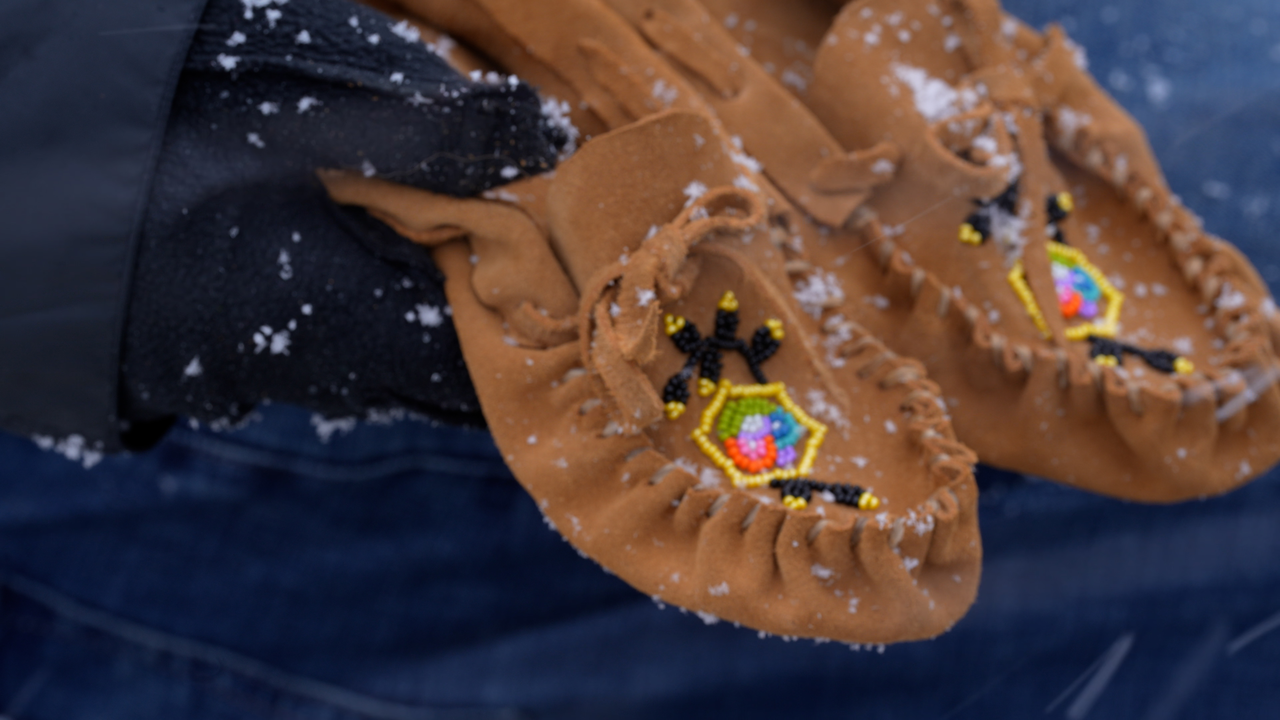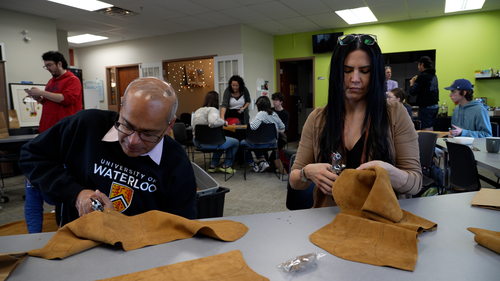
Indigenous students rock their mocs
WISC is building community and connection to Indigenous traditions

WISC is building community and connection to Indigenous traditions
By Sam Toman University RelationsAs far as campus traditions go, Soup and Bannock Days at the University of Waterloo Indigenous Student Centre (WISC) is a must-attend. Most Thursdays, volunteers make and serve soup to attendees while WISC staff dish out deep-fried balls of savoury bread — a traditional Indigenous treat. All are welcome to join.
“If I had a magic wand, I would love for an unlimited supply of bannock to magically appear,” says Arts undergraduate student Chole Brideau. “I’m not sure whether that comes in the form of a machine dispenser or a full-time fry bread connoisseur, but it would be the perfect any time-of-day snack.” She adds that she wants to talk to someone in Engineering about the possibility of a bannock startup.
Brideau is joking … maybe. It’s hard to tell because she’s been trading sarcastic barbs all afternoon with her friend Adele Trunecek. Today they’re here at WISC both for the crispy bannock and as part of Rock your Mocs, a moccasin-making workshop led by local Indigenous artist and entrepreneur Pandora Beausoleil.
Rock Your Mocs is a social media campaign encouraging Indigenous folks across Turtle Island to hand-make moccasins and spread their personalized Indigenous fashion on social media.
It’s the kind of programming and community-building Indigenous students find at WISC which welcomes Indigenous students from all backgrounds, regardless of status, reserve or urban background, or level of cultural knowledge.
Hosting that Thursday’s Soup and Bannock Days are members of the local #LandBack camp, many of whom are alums of WISC, so the attendance is quite good.
“I grew up in a small town so opportunities to reconnect with my culture were limited,” says Brideau who is from the Mi’kmaq community of New Brunswick. “My high school had a student Indigenous alliance club, but I never felt like my attendance mattered in any way, so I felt really estranged from my roots. When I got to Waterloo joined WISC everything changed for me. The space and people really make me feel at home.”
Trunecek agrees. “I feel like it’s a place that I can be myself without feeling any apprehensions about being judged for my sense of humor, the amount that I talk or any other aspects of my personality.”
This home away from home feeling is precisely what WISC is all about and continues to strive to be.
“I was a very shy kid who came to the city from a rez,” says Emma Rain Smith, an Aniishnaabe artist from Bkejwanong (Walpole Island) First Nation who made the transition from a student guest at WISC to its programming coordinator. She credits WISC with “making me the leader I am today. I want to encourage our youth to their full potential.”
Smith, along with WISC Director Savanah Seaton, are responsible for all things WISC, including today’s lunch and well-attended workshop.
“Being able to wear something that I made, without it falling apart, would definitely boost my confidence in the world of creating and crafting items of clothing,” says Trunecek.
Waterloo President and Vice-Chancellor Vivek Goel also attended for the workshop. Having made Indigenization a key priority during his tenure, he’s visiting WISC to work on a pair of moccasins and learn more about the Centre.

“I am so impressed by the feeling of sharing, cooperation, and togetherness here today. We still have so much work left to do to decolonize campus but supporting Indigenous students of all backgrounds to connect with their traditions one way we can move that process forward,” Goel says.
Smudging, beadwork, leatherwork and traditional crafts are all forms of art that are a part of the cultural revitalization happening at WISC.
“I liked the dream catcher workshop that was held closer to the beginning of this term,” Trunecek says. “Despite my dreamcatcher not turning out too great.”
“My secret to power writing an epic essay is definitely a good smudge,” Brideau adds.
The pair of students have an easy rapport and WISC is clearly a place where their friendship is being forged in a positive way. “My friendship with Adèle is filled with laughs and questionable remarks,” Brideau says.
“Exactly,” Trunecek says. “Since the first day I met her, we’ve seemed to be able to jokingly make fun of each other with the mutual understanding that nothing we say is serious. Like I can joke that Chloe is best friends with the stuffed bear that lives in the corner of the room at WISC. But I find that we can still have very interesting conversations about serious topics concerning mental health, current social situations and human rights issues.”
Seaton and Smith, who both began their roles at WISC this fall, see friendships like this develop and know they have something special. But a challenge that lies ahead is getting the word out to Indigenous students that WISC is there for them.
“Today was amazing! There were five students that came out that I had never met before. Sometimes it can take a bigger event to pull students to engage with non-academic activities,” Smith says. “But, those five new students will come back to access our centre to continue working with their moccasins.”
Simply meeting five new students may seem like a small act, but for Smith, “it’s pretty monumental.” She says that many of WISC’s students didn’t grow up in community with access to their cultures.
“Our goals are to support students holistically and a large part of that is the cultural and spiritual support that comes from gathering with food and just creating,” Smith says. “So, to see them explore their identity now because we can provide them space for that is amazing.”

Read more
Meet Dr. Sandra Lopez-Rocha from the Student Success Office

Read more
An end-of-year message from the President and Vice-Chancellor

Read more
Waterloo commits to decolonization, Indigenization and reconciliation
The University of Waterloo acknowledges that much of our work takes place on the traditional territory of the Neutral, Anishinaabeg, and Haudenosaunee peoples. Our main campus is situated on the Haldimand Tract, the land granted to the Six Nations that includes six miles on each side of the Grand River. Our active work toward reconciliation takes place across our campuses through research, learning, teaching, and community building, and is co-ordinated within the Office of Indigenous Relations.